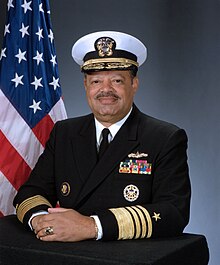
Stephen Bleecker Luce was a U.S. Navy admiral. He was the founder and first president of the Naval War College, between 1884 and 1886.From 1909 to 1910 he was vice president,from 1910 to 1911 president of the Aztec Club of 1847.
A destroyer squadron is a naval squadron or flotilla usually consisting of destroyers rather than other types of vessel. In some navies other vessels, such as frigates, may be included. In English the word "squadron" tends to be used for larger and "flotilla" for smaller vessels; both may be used for destroyer units. Similar formations are used in non-English-speaking countries, e.g., the "escadrille"—which would translate directly as "squadron"—in France.
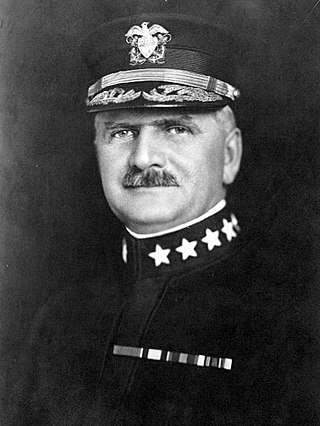
Robert Edward Coontz was an admiral in the United States Navy, who sailed with the Great White Fleet and served as the second Chief of Naval Operations.
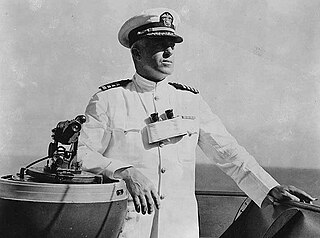
Daniel Judson Callaghan was a United States Navy officer who received the Medal of Honor posthumously for his actions during the Naval Battle of Guadalcanal. In a three-decades-long career, he served his country in two wars. Callaghan served on several ships during his first 20 years of service, including escort duties during World War I, and also filled some shore-based administrative roles. He later came to the attention of President Franklin D. Roosevelt, who appointed Callaghan as his naval aide in 1938. A few years later, he returned to command duties during the early stages of World War II. An enemy shell killed Callaghan on the bridge of his flagship, USS San Francisco, during a surface action against a larger Japanese force off Savo Island. He was the third of five US Navy admirals killed in battle during WWII, including: Isaac C. Kidd ; Norman Scott ; Henry M. Mullinnix ; and Theodore E. Chandler.

USS Coontz (DLG-9/DDG-40) was a Farragut-class destroyer leader/frigate in the United States Navy. She was named after Admiral Robert Coontz, the US Navy's second chief of naval operations.
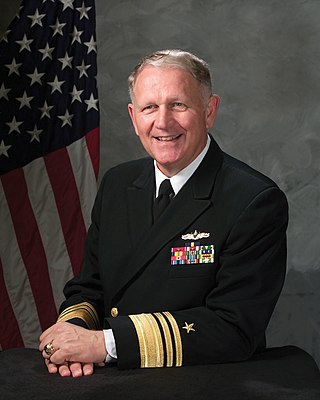
Rodney Paul Rempt is a retired Vice Admiral of the United States Navy who served as the 59th Superintendent of the U.S. Naval Academy from 2003 to 2007.
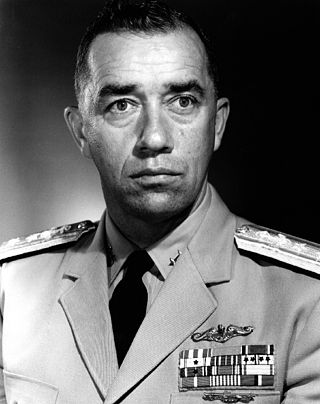
Eugene Parks "Dennis" Wilkinson was a United States Navy officer. He was selected for three historic command assignments. The first, in 1954, was as the first commanding officer of USS Nautilus, the world's first nuclear-powered submarine. The second was as the first commanding officer of USS Long Beach, America's first nuclear surface ship. The third was in 1980 when he was chosen as the first President and CEO of the Institute of Nuclear Power Operations (INPO) from which he retired in 1984.

Rear Admiral Gilbert Jonathan Rowcliff was an officer of the United States Navy during the First World War and the Second World War. After early service in the Far East, he specialised in gunnery, serving in that capacity on many US Navy capital ships. During World War I he served with the US Naval Force sent to join the British Grand Fleet.
United States ship naming conventions for the U.S. Navy were established by congressional action at least as early as 1862. Title 13, section 1531, of the U.S. Code, enacted in that year, reads, in part,
The vessels of the Navy shall be named by the Secretary of the Navy under direction of the President according to the following rule: Sailing-vessels of the first class shall be named after the States of the Union, those of the second class after the rivers, those of the third class after the principal cities and towns and those of the fourth class as the President may direct.

Samuel Jones "Sam" Locklear III is a retired United States Navy admiral who last served as the commander of the United States Pacific Command from March 9, 2012, to May 27, 2015. Prior to that, he served as Commander, United States Naval Forces Europe – United States Naval Forces Africa and NATO's Commander, Allied Joint Force Command Naples. Prior to that, he served as Director, Navy Staff from July 2009 to October 2010. He retired from the navy on July 1, 2015, after 39 years of service.

John Collins Harvey Jr. is a former United States Navy four-star admiral who last served as the 31st Commander, United States Fleet Forces Command from July 24, 2009 to September 14, 2012. He previously served as Director, Navy Staff (N09B) from March 24, 2008 to July 23, 2009. Prior to that, he served as the 54th Chief of Naval Personnel and Deputy Chief of Naval Operations (N1) from November 2005 to April 2008. He retired from the navy after more than 39 years of service.
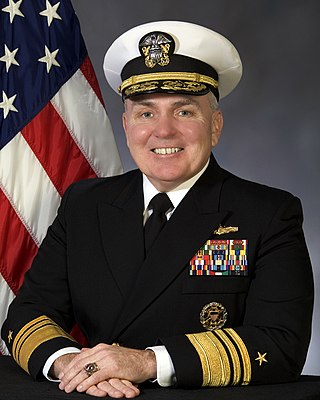
Vice Admiral Robert Thomas Conway Jr., is a retired officer in the United States Navy, who retired from active service on 1 April 2009. His last assignment was commander of Navy Installations Command, Washington D.C., where he led a startup organization of 18 navy admirals and senior executives, 60,000 military staff, government employees and contractors, in the management of 80 navy bases worldwide.
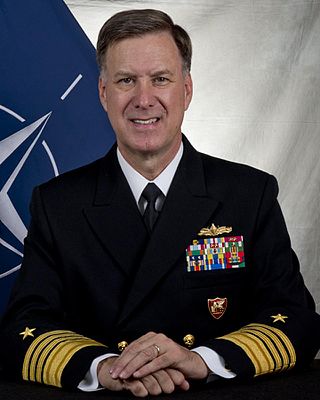
Mark E. Ferguson III is a retired United States Navy admiral who last served as Commander, United States Naval Forces Europe, United States Naval Forces Africa and Allied Joint Force Command Naples. Ferguson previously served as the 37th Vice Chief of Naval Operations from August 22, 2011 to July 1, 2014. Prior to that, he served as the 55th Chief of Naval Personnel and Deputy Chief of Naval Operations. He also served as chief of legislative affairs and assistant commander for distribution, Navy Personnel Command. He retired from active duty on July 1, 2016.

Vice Admiral Terrance Thomas Etnyre is a retired flag officer of the United States Navy.

Derwood Clayiborne Curtis is a retired vice admiral in the United States Navy who served as the Commander, Naval Surface Forces and concurrently Commander, Naval Surface Force, U.S. Pacific Fleet from March 2008 to June 2011.
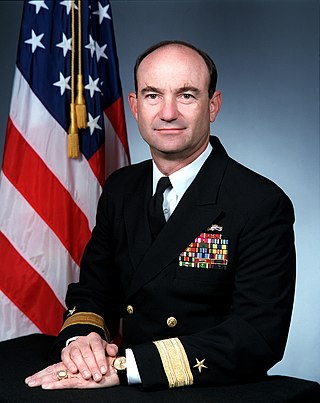
David Spencer Bill III is a retired rear admiral in the United States Navy.
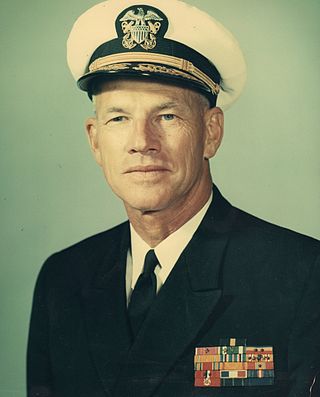
Lloyd Montague Mustin was a vice admiral in the United States Navy and among the namesakes of USS Mustin (DDG-89). He took part in developing the Navy's first lead-computing anti-aircraft gun sight, which proved of major importance in the air-sea actions of World War II, and he served on the cruiser USS Atlanta during the naval battle of Guadalcanal. His ship was lost during that action, and with other survivors he landed on Guadalcanal and served ashore with a naval unit attached to the First Marine Division. His postwar service included commands at sea and development and evaluation of weapon systems. He later served as director of operations for the Joint Chiefs of Staff during the Vietnam War.

RDML Stephen Frederick Williamson is a United States Naval officer. In 2015, Secretary of Defense Ash Carter announced that President Barack Obama had nominated Capt. Stephen F. Williamson for the rank of Rear admiral.

Vice Admiral Thomas J. Moore was a senior officer in the United States Navy. He retired from active duty on June 19, 2020, after 39 years of service. He currently serves as Vice President of Nuclear Operations at Huntington Ingalls Industries.
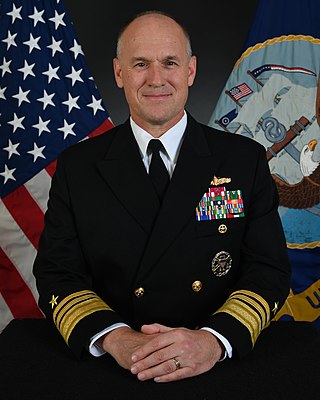
Eugene Henry Black III is a United States Navy vice admiral and career surface warfare officer who serves as the deputy chief of naval operations for operations, plans and strategy since October 7, 2022. He previously served as the 30th Commander of United States Sixth Fleet, deputy commander of United States Naval Forces Europe, deputy commander of United States Naval Forces Africa, and as the Joint Force Maritime Component Commander from June 2020 to September 2022.
